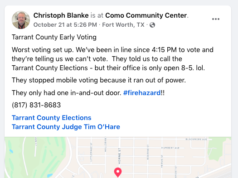Seeing a cool old neighborhood make a comeback gives us a warm feeling. We’ve seen it in Fort Worth on the Near Southside, for instance, where buildings with historic character get repopulated with new businesses and restaurants serving new customers under decades-old trees. I recently saw something similar in Kansas City, Missouri.
The city’s 18th & Vine district features dining establishments and jazz clubs that echo a rich past, and especially recalls the contributions the neighborhood’s African Americans made to the region’s culture. The 18th & Vine museum complex provides a hub for connecting with vital heritage, housing the American Jazz Museum and the subject of today’s video blog post, the Negro Leagues Baseball Museum.
I interviewed Bob Kendrick, the NLBM’s president. You don’t have to listen to him for long to get a feel for the immense passion he has for his favorite subject. After our interview finished, he noticed a student taking notes on the exhibits and walked over to initiate a conversation, no doubt effectively writing the young man’s assignment for him. Kendrick can talk knowledgeably about every aspect of African American baseball history, including the museum’s namesake Negro Leagues. The leagues formed in the 1920s to organize the great African American talent shut out of the Major Leagues by MLB owners’ so-called “gentlemen’s agreement.” In this video interview, we discuss in particular Rube Foster, a Texan who became the driving force behind their formation.
Kendrick is relentlessly optimistic by nature and the outlook of his museum reflects that attitude. Though he doesn’t sugarcoat the substantial injustice that necessitated segregated baseball, Kendrick’s chooses to focus on the inspiring achievements of the men and women (yes, there were important women in the Black baseball business) who overcame prejudice to create successful businesses and careers. That viewpoint reminds me of the neighborhood that surrounds the museum. It, too, doesn’t accept decay and adverse circumstances, instead creating a positive legacy for future generations.











